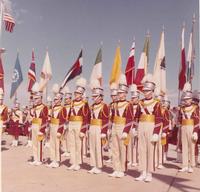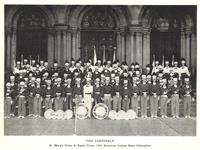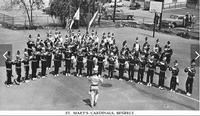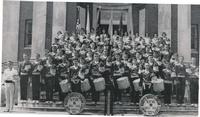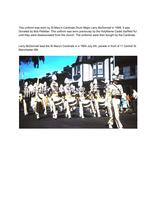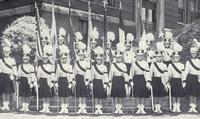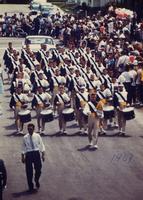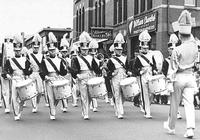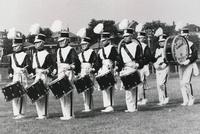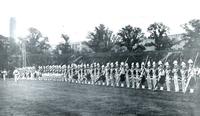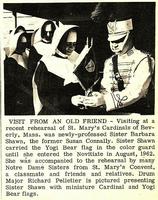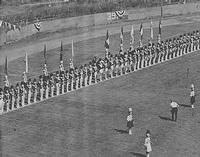St. Mary's Cardinals
Beverly, MA United States
Founded: 1948

The History of the St Mary's Crusaders and Cardinals 1948-1975
The year was Nineteen Forty Eight. In the city of Beverly, Massachusetts, a small group of men from St. Mary's Star of the Sea Parish met around a kitchen table in their home on Cabot Street to form the St. Mary's Drum and Bugle corps. That is now seventy years ago.
Joseph “Pop” Nuccio had a vision. He, his sons, Pietro (“Pete”), Vince and Frank, and a friend named Mel Deveau envisioned a church-based organization that would provide Beverly kids an opportunity to come together, learn, entertain, and grow as adolescents and to become strong, confident, contributing community adults. Drum and bugle corps was to be the vehicle that would keep dozens of kids off the streets. Little did they know that the St Mary’s Drum and Bugle Corps would become two; The St Mary's Crusaders and The St. Mary's Cardinals, eventually becoming the Beverly Cardinals and, through several iterations, eventually become The North Star nearly 30 years later.
Going back to February 1948, the Sons of Italy Drum Corps graciously donated their equipment to the Holy Name Society of St. Mary’s Parish in Beverly. During Sunday Mass, Monsignor John A. Degan sent out the call to the parish boys from twelve to sixteen years old to be part of the corps. Shortly thereafter, in the first week of April 1948, St Mary’s Drum & Bugle Corps had their first rehearsal with Arthur Poole as instructor. The “Off the Line” was learned, it was “The Bells of St Mary’s.” On August 8th, the corps made it’s very first public appearance, a field exhibition at the Holy Name Society outing at St John’s Prep in Danvers. Arthur Poole stayed an entire fourteen years with the corps.
“The Bells of St Mary’s” quickly became The St Mary's Drum & Bugle Corps first signature number. This easy to recognize tune, sung by Bing Crosby from the 1945 movie with Ingrid Bergman, was played in many parades and shows. The crowds loved it! Bob Barrett was the first drum major, leading the corps for nine years. He then entered the seminary to become a priest - Father Robert Barrett. Father James F. McNamara was appointed spiritual director. He helped The St Mary’s Corps from its inception until the corps tenth anniversary.
Members from the very early years are here tonight celebrating the 70th Anniversary. With us are Leo Maestranzi, John and Clara Sheehy, Shaun Silverio, Richard Renzie, Ron Dechene and Ron Ducharme. Leo remembers many details of those early days: From getting their first place trophies in 1950 at Newburyport and at the CYO Festival at Boston College, to very narrowly losing to the VFW National Chammpons Lt Norman Price in a combined Senior/Junior show in 1955.
Soon after the 1950 banner season, a younger second corps was formed for eight year olds and up. This new corps was called “The Crusaders” with the older corps later becoming “The Cardinals.” Pete Nuccio was very involved with the St Mary’s Corps from the beginning along with his brother Frank, a team that the Crusaders would have and cherish into the 1970’s. The Crusaders became the feeder corps for the Cardinals. This was instrumental to the success of the Cardinals for over twenty years.
The St Mary’s Cardinals started traveling a great deal, becoming Massachusetts and New Hampshire State Champions for three successive years - from 1954 to 1956. In 1954, the Cardinals entered their first National Competition, appearing in the 1954 American Legion Nationals in Washington D.C. Key people in the early 50’s committee were: long time manager Reggie Loiselle, Ed Trainor, and Archie McNeil and of course “Pop” Nuccio.
From the early 1950’s to the early 1960’s, much credit for the success of the corps must be given to Mr Larry Buckley, the drill instructor for the Cardinals and Crusaders. Larry, who marched with the National Champion Salem VFW post in 1939 and 1940, brought his disciplined style and expertise to the St Mary's Corps. By 1955, with Ron Deschene also as drum major, the St. Mary’s Cardinals placed 3rd at the VFW Nationals at Braves Field in Boston. In 1957, the corps placed 3rd in overall score at the Amvets Nationals, also held in Boston. By this time, the original charter members were aging out or “Graduating” as it was called at that time. This included, D.M. Bob Barrett, Leo Maestranzi, Jack Weir, Danny Shea, Gerry Marsella, Paul Hennessy, Mary Loretti, Ray Lord, Paul McNutt, Ron Dechene, Ron Ducharme, Danny Rena, Richard Renzie and Shaun Silverio
Father John M. Darcy came to the corps in 1958. Fr. Darcy would lead the corps though what could be termed as “The Golden Years.” Fr Darcy was very involved with the corps, they were his pride and joy. Wherever the corps went, Fr Darcy was there with them. He was truly their number one fan! Members of both Cardinals and Crusaders loved Fr. Darcy just as much. The years from 1958-1965 were unique. There was that symbiotic relationship the corps had with St Mary’s Parish and everyone thought it would never end.
With 1958 came a new drum major, Larry McDonnell who led the corps for two years. Competitively, the corps kept up because the Crusaders were now feeding the Cardinals experienced players in increasing numbers. This helped the typical 27 players (that most hornlines had at the time) increase in size and quality of sound. In 1959, the Cardinals purchased the entire set of uniforms from the national champion, Holy Name Cadets of Garfield NJ, who were suddenly and involuntarily dissociated from their parish. During this time, the Cardinals had a “sister corps” - The Holy Trinity Cadets of Boston. A strong camaraderie existed between the corps, at the end of a show during retreat, if one of them won, the corps would form honor guards for each other. When both corps played St Louis Blues the same season, they actually combined corps, and marched off together taking turns playing the number!
In 1960, another change in drum majors occurred. A young 16 year old named Dick Pelletier took command of the corps. Another significant change was the arrival of Arthur Kirwan on drums, a most Precious Blood Crusaders and Lt Norman Princemen alumnus. The drum line would progress in leaps and bounds. Arthur would remain for the next ten seasons till 1970.
The 1960 and 1961 edition of the Cardinals was a huge move forward in sound and competitiveness. Bass Baritones were added to the hornline and beautiful new drums in “Mother of Pearl” finish. Then in 1960, at the CYO Festival in September, The St Mary’s Cardinals were crowned champions. It was an upset victory at CYO Finals, defeating the 1960 National Dream Champs,The St Kevin’s Emerald Knights. This show would be the last time the Cardinals wore the Holy Name uniforms, the set being returned to The Garfield Cadets soon after the season.
With the new decade came new uniforms again - actually, two sets of uniforms. The competitive uniform was a satin burgundy and white top, with gold cumberbund. A “Summer” parade uniform consisted of a white top with maroon collar and cumberbund. Both sets of uniforms had cream colored pants with stripe. The color guard continued to wear the maroon, cream and gold uniforms through this era with only slight changes. This became the signature uniform of The St Mary’s Cardinals Color Guard, worn until 1968.
Over the 1950’s and early 60’s, the color guard had come into its own under the tutelage of Duffy Callahan, Louie Green and then Danny Shea. It seemed like every young lady in Beverly wanted to join. Scores of young teenagers went through color guard “tryouts’ for just the few spots available. Then, in 1962, another instructional move occurred - the great Lt. Norman Prince drum major and horn instructor of St Rose Scarlet Lancers and Cambridge Caballeros, Al Saia, arrived in Beverly for a five year stint. Now with Larry Buckley on drill, Arthur Kirwan on drums and Al Saia on horns, St Mary’s would fly via propeller plane out to the 1962 VFW Nationals to test their fortunes. The VFW and American Legion Veterans Organizations dominated the national drum corps scene at this time. The corps made the finals and performed at the night show in front of a packed Stadium. It was August 1962, and everyone in the country’s drum corps community knew of the St Mary’s Cardinals from Beverly.
The year 1964 saw more changes. The well known and affable Jack Whelan was now in Beverly teaching drill. Another set of new cadet style uniforms was purchased for the corps. The classic “Maroon and Gold” cadet top, gold cumberbund and cream pants, that now matched the color guard outfits. This uniform, known to many as the “signature uniform” for the corps, was worn until 1968. A big crop of rookies came up from the St Mary’s Crusaders in 1964. New music from Al Saia, consisting of Heat Wave, San Francisco, I left my Heart in San Francisco and No Other Love were huge hits. The excitement of the Cardinals coming “off the line” playing Tropical Heat Wave, marching in a company front stretching from sideline to sideline out to the fifty yard line, then doing a 90 degree wheel, and coming into the stands, delighted the cheering crowds in the stands. This was a completely novel move for the era. The one thing that most corps fans around the country can still remember about the Cardinals to this day is the corps doing “The Wheel” playing Heat Wave!
The summer of 1964 found the Cardinals going head to head with the undefeated Boston Crusaders in every Eastern Mass Circuit show, with the Crusaders coming out on top everytime. However, just prior to leaving for the VFW Nationals, the Corps came into stride, defeating the best Boston Crusaders corps to date. This was Aug 23rd 1964, in Lawrence MA, lifting the corps hopes for a first national title. The day after the Lawrence show, the Cardinals traveled by bus to Cleveland Ohio to the VFW Championships. Prior to leaving there was a huge send off by parents and fans. The St Mary’s Crusaders played their routine for their older brothers and sisters in front of the St Mary's School on Federal St.
Arriving in Cleveland wIth drum majors Dick Pelletier and Jerry Lamontagne leading the corps, the Cardinals, Boston Crusaders and St Kevins found stiff competition from the midwest corps. In prelims, The Kilties were in first place, followed by The Royal Aires, with St Kevins and Boston Crusaders tying for third. The Cardinals trailed both corps by a mere one tenth of a point. The Cardinals fell in finals to 9th place, but made their mark on the national scene. The Kilties were the VFW champions that year.
The 1965 Cardinals saw another large influx of rookies come in to replace the veterans that left after 1963 and ‘64. Jim O”Brien, Paul Genest, Donna Daley, Bob Latini, Linda Cormier, and many more had aged out. The hornline was enlarged to 52 horns, this was unprecedented in the activity. Heat Wave, with the huge company front and “The Wheel” was held over from 1964. However, a new color presentation was developed with the corps playing Mr. Wonderful. This number was arranged by Al Saia, ended with the presentation of the American Flag and the hand painted “John F Kennedy Flag”, in memory of our recently fallen president. It was an emotional tribute appreciated by audiences all over.
The Cardinals went back and forth during the 1965 summer, trading victories with St Kevins and Boston Crusaders. In August, the Corps flew out to Chicago for the VFW nationals and found the toughest competitive field to date. The Royal Aires had their year, and were champs. The Cardinals made the final top 15, placing 12th. Many people say this was a fabulous show, never to be forgotten. The corps was competitively successful, but the trip ended in disappointment. The Cardinals stayed local for the next few years. This was the finale of Dick Pelletier’s six years as drum major. He will always be remembered for his great leadership, showmanship and dedication to The St. Mary’s Cardinals.
In 1966, the corps had a very good year. Returning were drum majors Jerry LaMontagne, Dave McDonnell. Heat Wave was gone; the new “Off the Line” was Cheek to Cheek, the all time favorite tune among Cardinal members.
The corps saw a new drum major in 1967, Jim “Mac” McKenzie, and a change on the horn staff. The great Al Saia retired. The new instructor would be Rick Connor, a Berkley School of Music Major and Cambridge Caballero alumnus. Rick would instruct the Cardinals hornline for the next eight years, keeping the corps in national contention. The Cardinals were also fortunate when long-time member and alumnus Paul Harris came back to help out for the 1967 season. Paul was instrumental in the development of horn players in the St Mary’s Crusaders for years and now got an opportunity to instruct them as Cardinals.
The show was again Tropical Heatwave and Cheek to Cheek was turned into a production number. The Corps scored well in the CYO Nationals and World Open both years. The 1967 American Legion Nationals, held at Fenway Park, saw the Cardinals place a strong third in prelims, ahead of Cavies and Blessed Sacrament, before falling to sixth in the finals. Corps members from that summer season remember that American Legion finals performance to be one of their best ever.
In the Fall of 1967, yet another large batch of St Mary’s Crusaders graduated to the Cardinals. After the corps strong finish at the American Legion Championships the previous summer, hopes were high for that elusive national championship. Ron Genest was selected to be Drum Major and was an inspiration to the corps. There was an extremely talented horn, drumline and color guard. Jack Whelan, Rick Connor and Arthur Kirwan were the instructional dream team.
The first show was at Symphony Hall in February 1968. This saw the Cardinals defeat St Kevins with the drum line scoring an incredible 29.9 out of 30 points. Soon came the trip to Quebec Canada, with the corps doing a fabulous midnight exhibition at the Ice Festival. A strong showing at Drumfest followed, barely losing to the Boston Crusaders, but defeating the new 27th Lancers Corps from Revere.
The stage was set for a great year. However, the Vietnam War was now raging and “the draft” hit the corps. Drum major Ronnie Genest, was drafted, gone in May. The Cardinals new drum major would be Frank Raffa, who would lead the corps through the 1972 season. Heat Wave was gone again; Free Lance would be the new “March” played “Off the Line.” The summer of 1968 saw the Cardinals coming in 3rd to another strong Boston Crusaders and the new 27th Lancers, a powerhouse and darlings of the audience. The Cardinals were invited and performed that summer at the National Dream Show in New Jersey, and held their own at the World Open and CYO Nationals. The corps was traveling again and traveled to New York twice for big shows. A bus trip to New York in September would be the corps last. The next day on Sept 8th 1968, St Mary’s Cardinals were the CYO Champions one final time over St Kevins. However, on the ride home after that show, the corps was told there would be a meeting in the St Mary’s school hall. The corps was gathered, spoken to about the bus trip, and the spiritual director Fr. Leo X. Lynch, looked at his watch and proclaimed “As of 7.30 pm, September 8th 1968, the St Mary’s Cardinals are now now defunct”.
At the very moment of this proclamation, the entire corps made a collective gasp and shrieks of anguish could be heard. Everyone looked at each other in disbelief, a moment for those who were there, that will never be forgotten. The corps was told to leave everything at the school - horns, drums, flags,uniforms and leave. Outside in the St. Mary’s school yard, the members walked around dazed by what had just happened. Comically, some members did not know what the word “defunct” meant until explained. This was the news the next day, printed in two inch bold type headline across the front page of The Beverly Times.
What happened next was incredible. The retired committee members, alumni and the Beverly community rallied. The corps would not be lost. A new corps called “The Beverly Cardinals” was born. This new corps had nothing, but continued practicing drill at Cherry Hill Farm without instruments or equipment for the one show left in the season.
The final show in 1968 was held on September 21st in Lawrence, MA. This was a memorial show for the Marino Family who lost their mom in a tragic car accident driving back home from the World Open show in Lynn. The Cardinals appeared on the starting line with white shirts, maroon ties and black pants with horns borrowed from their rivals, The Boston Crusaders and drums and shakos from the White Eagles of Lawrence. The “New Cardinals” corps received a thunderous ten minute standing ovation from the crowd. Performing their hearts out to the roaring approval of the audience, a very special moment those who were there that will always be remembered.
The year 1969 saw a rebuilding year for the corps. New and used equipment was purchased, but it took until spring to have a complete set of horns. The corps, committee and parents were revitalized. Reggie Loiselle, Frank Nuccio, Pete Nuccio, Al Pelletier and many others came to the Cardinals rescue along with a new Parents Organization. Jack Weir returned to the Cardinals as the head drill instructor. The Cardinals were able to field a very respectable corps, culminating in a trip to Philadelphia for the 1969 VFW Nationals.
The St Mary’s Crusaders continued, now known as The Beverly Crusaders. They got to keep their equipment and uniforms which they had purchased on their own. The Crusaders were still led by manager Pete Nuccio, with Joe Nuccio on Horns, Ronnie Genest on Drill, followed by Peter Nuccio, along with Dom Napolitano on Drums. They continued to feed new members to the Cardinals for several years. The Crusaders remained active until 1980, winning the Eastern Mass. Class C Championship six times: 1963*, 1964*, 1965*, 1972, 1973 and 1978 (*undefeated).
By 1970, the Cardinals had recovered from the disbandment. The new uniform tops were white with a maroon sash. The color guard went with outfits of maroon, gold and white. There was a new young and brash drill instructor, Joe Casey, who gave the corps a fresh and innovative approach in drill. Joe would teach the corps for six years, giving the corps the discipline it needed (just ask anyone who was a member of Joe’s “Breakfast Club”). The corps saw a significant influx of new and very talented members that had come from The White Eagles of Lawrence. This brought the corps up to a new level and new friendships were formed. The hornline was again approaching fifty horns with a full drumline. The Vietnam war was still going on, but times had changed. With this change the Cardinals’ staff came up with a Peace Theme, complete with a custom arrangement by Rick Connor that included Hare Krishna, Give Peace a Chance, Blowing in in the Wind into Battle Hymn of the Republic for a Color Presentation. The Color Presentation was done with a “Peace Flag” that became very controversial, appearing in newspapers across the country. The audiences loved it, giving standing ovations for this Peace Medley throughout the season.
The cadet style uniforms were back for 1971 and were worn for the first time in June at the United Organization of Junior Corps show (pre Drum Corps International) in Lawrence, Ma. Very similar to the classic uniform worn in the sixties, it gave the corps a new look. The Drum and Bugle Corps activity saw its peak in number of units in 1971. This made National competition quite fierce for all corps. The Cardinals were in the top 20 corps in the country that year and made finals, 10th place at the US Open in Marion OH. This is the year that the introductory “Fanfare” for Tropical Heat Wave was played the final time in the routine. The following year in 1972, saw a change in drum staff to Jerry Shellmar of Boston Crusader fame, who brought the drum line to a different place, learning how to read music. The corps played a new “Off the Line”, Stan Kenton’s “Fanfare for the New”, undoubtedly the most difficult number the Cardinals ever played. Another new number was Get it On and Blue Rondo ala Turk, very progressive for 1972.
By the winter of 1973, momentum of the reorganization after leaving the church had waned, “The Committee” had dwindled down to a few and membership attending rehearsals was under 20 players, but still a strong nucleus of talent. Something had to be done and in the spring of that year, manager Jim O’Brien took the lead and The Beverly Cardinals merged with The Wilmington Crusaders. Again, many new friendships were formed. Mr Jim Lutz and Mike Cahill were added to the staff. The corps re energized quickly for the summer with a hundred members on the field. Jim Galvin was the drum major after returning from his time with the United States Marines Corps. Jim wore the classic 1965 corps cadet top for his uniform. 1973 was still a rebuilding year, but paved the way for following season.
In 1974, the Cardinals matured with a good mix of veterans and rookies. Playing Fanfare for the New, Get it On, Nights in White Satin, Hummingbird, and the Entertainer from “The Sting” the corps was again competitive nationally. The corps regularly topped the Boston Crusaders, 27th Lancers, Blue Rock, Bridgemen, and Pembroke Imperials. The brass line was one of the Cardinals best ever, in fact close to surpassing the incredible Hawthorne Muchachos for top horns at DCI East in Lowell. Led by drum major Joe Grenier, the Cardinals made finals in all shows, but DCI.
The final edition of the Cardinals was in 1975. New satin tops, similar to the red satin of the 1950’s were worn by the corps proper, the color guard was in black. The whole corps wore the distinctive black “Poobah Hats” for this one year. Many veterans had left after the 1974 season, so the corps needed to absorb new members by merging with the corps from Melrose. Jim Dennesen was the veteran who became DM for this season, assisted by Stevie Dowling. The corps had a demanding schedule as they were DCI associate members now. The corps was young and was just outgunned by the other DCI corps heavyweights. This was the last year of the Cardinals, but thanks to Manager Jim O”Brien the corps stayed alive. The Cardinals merged again in 1976 and became The North Star. Many Cardinals remained and became part of this vibrant new corps to come on the scene. The North Star were extremely successful until 1982. North Star made three straight DCI Finals. The corps got that elusive National Championship at CYO Nationals in 1979. Every Cardinal can be proud of the the legacy they left to be continued by North Star.
There is no single year of The Cardinals Drum & Bugle Corps that was more important than any other. Everyone had their own “slice of time” with the corps and their own recollections. The “one thing” that we all may agree on:
“Every year of the Cardinals existence from 1948 -1975 was important to all of those who dedicated themselves each year to be the best they could be.”
Written by Phil Dennesen- Member 1963 to 1974 for the Cardinals 70th Anniversary & Tribute.
-
1953 2 scores
Highest Score 0.000
Final show in DCX Archives October 18, 1953 Medford MA
-
1954 2 scores
Highest Score 85.500
Final show in DCX Archives August 29, 1954 American Legion National Championships - Juniors Washington DC placed 11 with a score of 76.430
-
1955 2 scores
Highest Score 86.850
Final show in DCX Archives August 31, 1955 VFW Boston MA placed 3 with a score of 86.850
-
1957 2 scores
Highest Score 82.450
Final show in DCX Archives June 30, 1957 Portsmouth NH placed 6 with a score of 82.450
-
1958 1 scores
Highest Score 87.560
Final show in DCX Archives August 2, 1958 Fitchburg MA placed 2 with a score of 87.560
-
1959 1 scores
Highest Score 87.500
Final show in DCX Archives August 1, 1959 Worcester MA placed 2 with a score of 87.500
-
1960 4 scores
Highest Score 88.360
Final show in DCX Archives September 6, 1960 E-Mass Finals Marlboro MA placed 3 with a score of 85.860
-
1961 4 scores
Highest Score 87.000
Final show in DCX Archives October 1, 1961 Waterbury CT placed 3 with a score of 85.000
-
1962 11 scores
Highest Score 88.950
Final show in DCX Archives September 16, 1962 Eastern MA Circuit Championships Malden MA placed 3 with a score of 84.900
-
1963 16 scores
Highest Score 87.400
Final show in DCX Archives September 21, 1963 Serenade of Champions Danvers MA placed 3 with a score of 79.896
-
1964 24 scores
Highest Score 85.750
Final show in DCX Archives October 5, 1964 Haverhill MA placed 1 with a score of 80.710
-
1965 22 scores
Highest Score 85.200
Final show in DCX Archives October 3, 1965 Eastern Massachusetts Circuit Championships Malden MA placed 2 with a score of 77.930
-
1966 14 scores
Highest Score 86.920
Final show in DCX Archives September 11, 1966 MA CYO Boston MA placed 2 with a score of 80.700
-
1967 9 scores
Highest Score 85.133
Final show in DCX Archives August 29, 1967 CYO Nationals Boston MA placed 8 with a score of 77.780
-
1968 7 scores
Highest Score 75.900
Final show in DCX Archives August 31, 1968 World Open Prelims Lynn MA placed 7 with a score of 75.900
Members (9)
| Member Name | Section | Years Involved |
|---|---|---|
| Belfiore, Paul | soprano horn | 1967 to 1968 |
| Dennesen, Phil | Mellophone | 1968 |
| Haas, Bill | Contrabass | 1968 |
| Jewett, Dave | Bugle | 1964 to 1968 |
| Lebel, Richard | Horn | 1961 to 1965 |
| Lucido, Bob | 1st Soprano | 1958 to 1963 |
| McKenzie, Jim | Drum Line | 1960 to 1968 |
| Mulligan, Jack | Horn (Baritone) | 1956 to 1959 |
| Ward, Mike | Baritone | 1962 to 1966 |
LOADING.....

